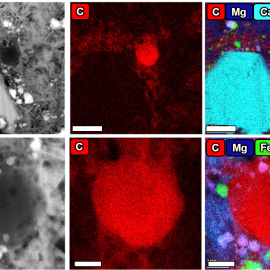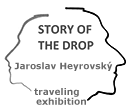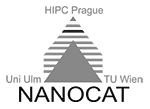A Czech-led consortium was the first to see the 3D structure of organic material older than the Earth. The sample came from asteroid 162173 Ryugu returned to Earth by the Hayabusa-2 spacecraft
An international, Czech-led consortium was the first to observe the 3D structure of preserved organic matter from the near-Earth asteroid Ryugu. These rare samples were collected by the Japanese Aeronautic eXploration Agency JAXA‘s Hayabusa-2 spacecraft in 2019. In 2022, JAXA first allocated these samples to only a few countries, including the Czechia. Thanks to this, Czech scientists from the J. Heyrovsky Institute of Physical Chemistry of the Czech Academy of Sciences CAS, in collaboration with CEITEC in Brno and TESCAN, were able to analyse these samples in unpresendented detail and gain important insights into the evolution of organic matter preserved for 4.5 billion years. The initial findings of their research have been published in the prestigious journal Nature Communications.
The samples from asteroid Ryugu are similar to a small group of meteorites called CI chondrites (named after the Ivuna carbonaceous chondrite meteorite), which formed in the early Solar System just a few million years after the Solar System's birth over 4.5 billion years ago. CI chondrites represent the most primitive material ever found in the solar system, whose major elemental compositon are the most similar to the composition of the Sun. Furthermore, the study of these extraterrestrial bodies helps us understand the the earliest stages of aqueous and organic evolution during the early solar system.
Organic Matter from the Birth of the Solar System
JAXA provided the Czech researchers, led by Hitesh Changela, with a grain of Ryugu approximately 1.5 mm across for the study.
"The research on Ryugu asteroid samples in our laboratory highlights the significant differences in the data that scientists can obtain. The Hayabusa 2 mission brought back 5 grams of samples from one of the asteroids at enormous cost. These samples are so rare that they were sent to only a few laboratories, including ours, and could only be studied using microscopic techniques,” said Martin Ferus, head of the Department of Spectroscopy at the J. Heyrovsky Institute of Physical Chemistry.
"A challenge lies in maximising information and minimising destruction on the most fragile extraterrestial samples we have returned to Earth," added Hitesh Changela.
Radegast - A Grain Only Slightly Larger Than a Grain of Sand
The grain, labeled A0083, was soon after its arrival named "Radegast" (after the Slavic Pagan God) and is only slightly larger than a coarse sand grain.
The researchers examined the sample using a range of advanced microscopy techniques. Using FIB-SEM (Focused Ion Beam – Scanning Electron Microscopy), they performed tomography on a section of the sample measuring 60 x 65 x 20 μm, which is less than the width of a human hair.
During this process, a Xe+ ion beam gradually "cut" layers of material only 25 nm thick. Hundreds of images of these "slices" were then taken using a scanning electron microscope (SEM) and assembled into a tomogram, providing information about the 3D distribution of matter within the studied sample. Czech scientists were thus the first in the world to visualize the 3D structure of organic material older than Earth itself.
For identifying the minerals present, they used spectral analysis of X-rays (EDS) produced by the interaction of the sample with high-energy electrons in the SEM. More detailed images were provided by transmission electron microscopy (TEM). These detailed images reveal the omnipresent clay mineral (mainly serpentine and saponite), in which grains of, magnetite (Fe3O4), iron sulfides, phosphates, carbonate and organic matter are embedded. This mineralogy is evidence for the alteration of primary silicate minerals from the Solar nebula (e.g. olivine, pyroxenes, glass) by water that flowed through Ryugu in the early solar system.
Function chemistry of the organic matter was also determined using synchrotron radiation analysis (STXM-XANES) conducted by collaborators at Yokohama National University and the KEK Photon Factory synchrotron in Japan. Coordination of these techniques with high-resolution TEM imaging confirmed the presence of organic particles and diffuse organic matter dispersed in the omnipresent clay minerals. While the nature of the organic particles is rich in hydrophobic aromatic compounds, the diffuse organic matter is rich in polar carboxyl groups.
These findings provide valuable insight into the nature of organic matter that would have probably been delivered to Earth's surface in the early stages of the solar system and could have been a crucial raw material for the origin of life on our planet.
"In contrast, our spectral survey of meteors from Earth, from stratospheric balloons, or space satellites provides only a fraction of the information, mainly about their elemental composition. However, this observation can be made for a vast number of asteroid and comet fragments that cross Earth's path, enter the atmosphere, cause meteors, and disintegrate. Spectral and image recording is thus the only source of information about their composition and origin. Our goal is to use the knowledge gained from Ryugu research and meteorite samples in our laboratory, our own observations of meteors from stratospheric balloons and space satellites, to develop instruments that can be sent aboard inexpensive CubeSats directly to asteroids and comets, which will bring unprecedentedly precise and detailed data comparable in quality to ground laboratories,” added Martin Ferus.
International Collaboration
The international consortium led by researchers from the J. Heyrovsky Institute of Physical Chemistry of the Czech Academy of Sciences was formed to study Radegast. The consortium also included researchers from the Central European Institute of Technology CEITEC, TESCAN ORSAY HOLDING a.s., and Mendel University. Foreign participants in the study included scientists from the University of Leicester (UK), the National Technical University of Athens (Greece), and the National University of Yokohama, the KEK Photon Factory and JAXA (Japan).
The examination of Ryugu asteroid samples is part of long-term research on interplanetary matter and the evolution of organic substances similar in composition to the building blocks of life on early Earth. Currently, the team from the J. Heyrovsky Institute of Physical Chemistry is planning a mission to develop an instrument for the spectral study of meteors from a stratospheric balloon and subsequently for the European space robotic laboratory Space Rider.





























